Editorial: Why Microsoft Surface isn't growing after seven years of trying
Across seven years of Microsoft's Surface experiment in designing and selling hardware, the company still hasn't found a breakout hit product. It now offers more products than ever-- six major product lines, compared to the two it started with at the end of 2012. Yet its revenues have barely budged across the last decade. This quarter, Surface sales fell 4 percent over the year-ago quarter.
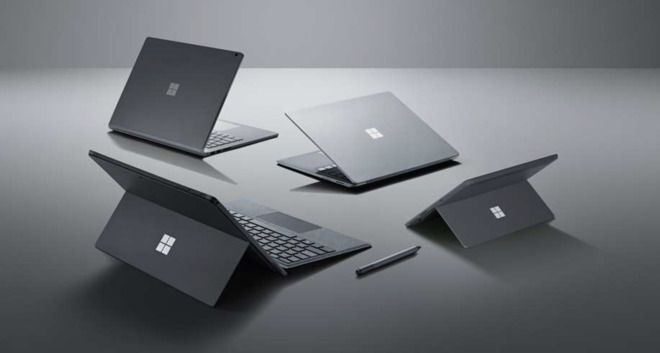
Surface is all about the Microsoft logo
That stagnancy reflects a conspicuous lack of progress for a unit hailed as by many fans as the creative center of the PC universe and perhaps the maker of best Windows PC one can buy.
Microsoft blamed the "timing of product lifecycle transitions" for lower Q3 sales this year. The company just showed off its refreshed Surface Pro 7, Surface Pro X, and Surface Laptop 3 models earlier this month, so this quarter is certainly the slowest in the annual cycle of Surface as buyers waited for those products to become available.
The cyclical nature of Surface sales -- peaking in the December quarter and then collapsing in half before the next batch is released -- also indicates that Microsoft has created a marketing-driven cycle similar to Apple's historically seasonal sales of iPods, iPhones, and iPads, and its educational sales of Macs. The difference is that Microsoft's cycle doesn't move up and down that much.
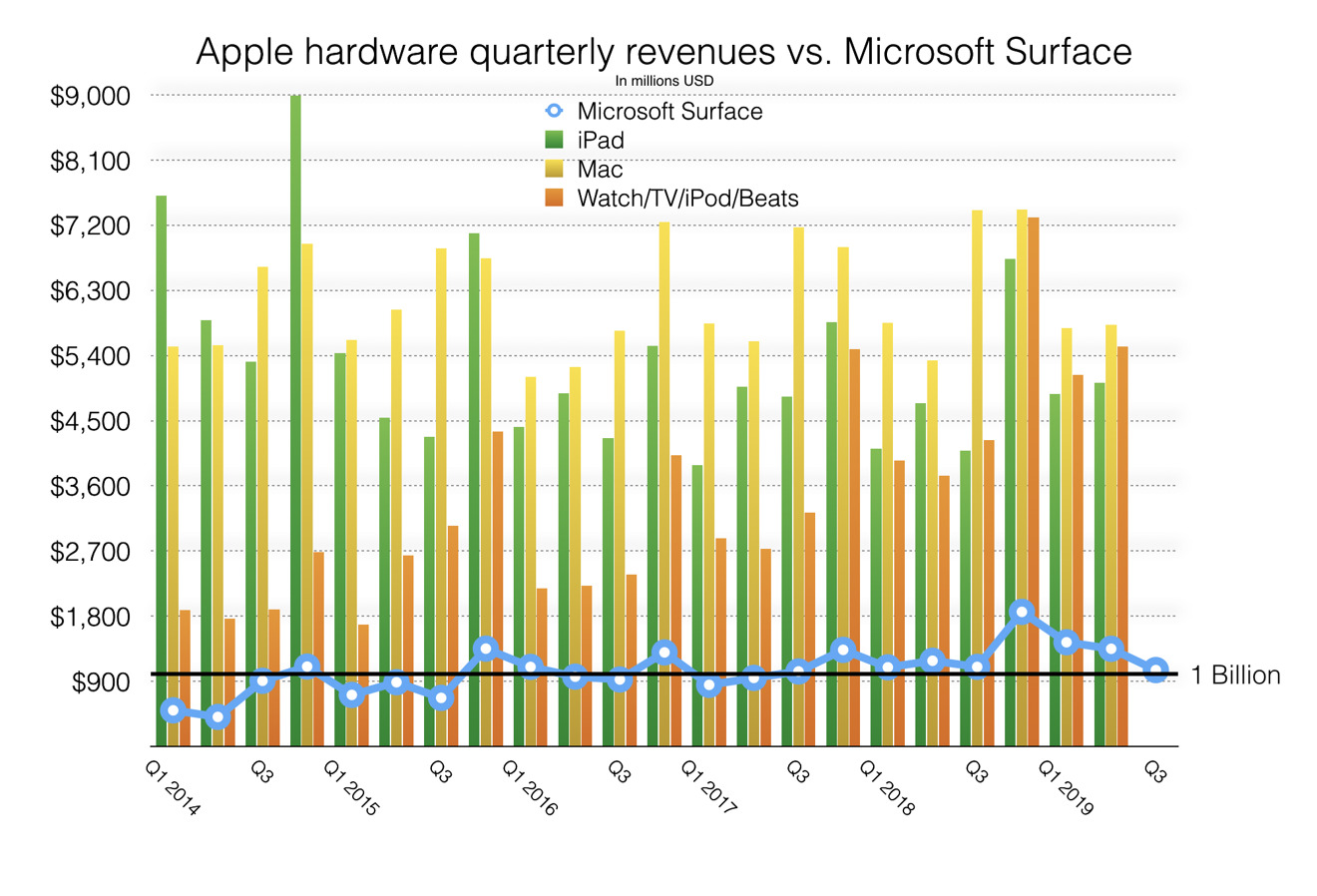
Surface hasn't grown the way Apple's new product introductions have
Five years ago, Apple's "other" sales including iPods and Apple TV were written off as immaterial by critics. Surface was starting its second year of sales and was shipping $900 million of product, just under half of Apple's $1.9 billion of other hardware revenues.
Over the five years since, Apple launched a series of "other" products that pundits like to say "don't move the needle," including Apple Watch, AirPods and HomePod. Microsoft has been applauded over the same period for introducing various unconventional PC designs and detachable notebooks, including everything from the inexpensive $400 Surface Go to $3,300 notebooks, a $4,800 Studio desktop, and even a $22,000 whiteboard called Hub.
Yet five years later, Microsoft's Surface unit is still turning in the same roughly $1 billion in revenues. Apple's other hardware revenue has crept upward from twice that of Surface to three times, and while Apple hasn't yet reported figures for its calendar Q3, it most recently reported more than four times Surface revenue from its 'other hardware' sales: over $5.5 billion in the June quarter, compared to Surface with almost $1.4 billion.
Apple's significantly growing 'other hardware' represents innovative new product categories and initiatives in emerging areas such as wearables and home audio. Surface has repeatedly tried to polish the Bill Gates notion of a convertable Tablet PC to look more like an iPad, without much real-world success at all.
Apple's "other hardware" also hit a cycle high over the last holiday quarter-- reaching revenues of $7.3 billion, nearly four times the highest height of Surface. Yet the language used to describe Apple's "other" products and accessories is dismissive, while Surface is hailed as "showing real growth" and "really seriously becoming a business now." Why does a company with an often higher market valuation than Apple need to be appeased with participation trophies and pats on the back for failing to appreciably grow and earn money?
Across its product lines, Apple has always driven annually cyclical sales. But sales of PCs are less cyclical. If Surface were reaching enterprise customers and selling to businesses, it should be seeing sales patterns more like HP, Dell, and Samsung, which are far less cyclical than Apple. That indicates that rather than building a real base of demand for its creative PC designs, Microsoft has instead only created a niche of fans that it serves with waves of replacements.
Surface originally appeared as a response to the iPad, which immediately began crushing PC sales after it appeared in 2010 and began Disrupting the market. Common PCs and notebooks were over-serving most users' needs while introducing excessive complication into their lives. The super-simple and highly mobile iPad appealed to everyone from children to business executives.
To blunt the iPad's impact and shore up Windows sales, Microsoft intended to deliver an "RT" version of its platform capable of running on the same kind of light, power-efficient ARM hardware Apple was delivering.
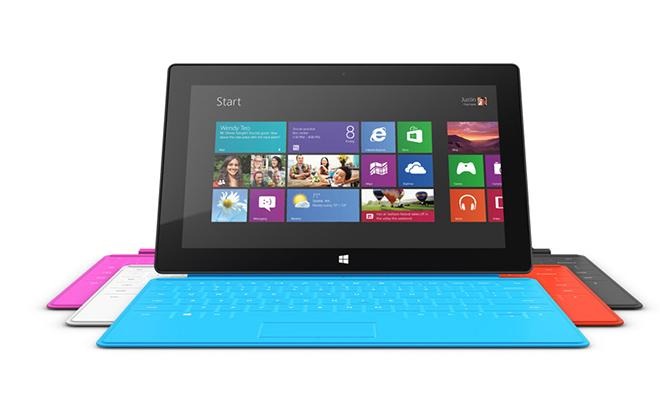
Surface RT was suposed to be the PC for iPad users
Microsoft's original Surface model was a $400 ARM-based Windows RT product, flanked by a more conventional, low-voltage x86 Surface Pro model that the company compared to Apple's MacBooks. Surface RT flopped dramatically across four years of trying because it didn't do what Windows customers expected of a Windows device: run most Windows software. That left Microsoft to focus on Surface Pro as its mobile, x86 PC tablet designed to be used with a keyboard and stylus.
Gartner did, however, claim last fall that Microsoft had importantly entered the top five PC makers in the U.S. The only way Gartner could make that claim is by comparing Surface against none of its actual competitors. It excluded sales of both Chromebooks and iPads, effectively measuring Microsoft against itself and the four much larger conventional PC makers in the U.S. that include Apple's Macs on their own.
Tom Warren of the Verge reported the facts that outlined what a sham "achievement" this was for Surface after six years of trying, but that same site also continues to declare that Microsoft is "a top five vendor," even though the reality is that Gartner only ever estimated quarterly sales of 600 thousand Surface units in the U.S. And unlike Apple, Microsoft's Surface is largely sold in the U.S. It only has two retail stores outside of North America.
Despite such a broad range of products -- growing from two to five broad product lines of PCs -- Surface sales haven't materially grown into a business, and certainly not one comparable to Apple's iPads or its Macs. Why is the monopoly platform of Windows unable to reach buyers with its hardware at any price?
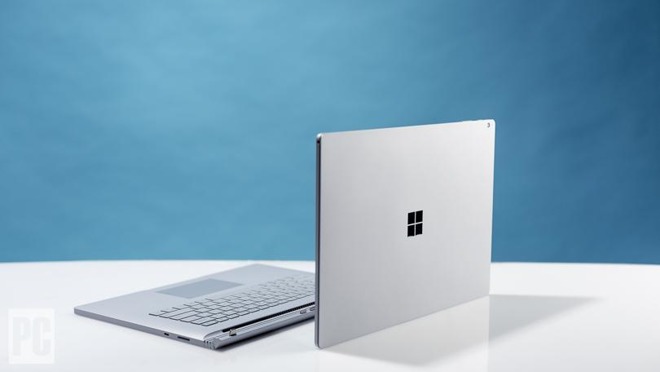
An unhinged Surface PC reflects the tech media's enrapturement with impractical, unsuccessful experimentation
Apple's sales of iPads peaked in 2014 with sales of $8.9 billion, right before Apple began selling larger iPhones that erased some of the markets for standalone tablets. Yet for all the ink spilled on the collapse of iPad, Apple's tablet sales have remained a $4-5 billion quarterly business. Similarly, Mac sales have hit peaks of around $7.5 billion in some quarters, but are pretty solidly selling at around $6 billion per quarter. Combined, Apple's non-iPhone computing hardware sales are around $10 billion per quarter-- peaking above $14 billion over the last holiday season, where Surface hit its all-time high of $1.8 billion.
Surface has a larger problem than just being much smaller than Apple. It's not large enough to be sustainably profitable. Microsoft reports Surface revenues, but not profits. The company now maintains five product lines that compete with iPads and Macs, but only has a fraction of Apple's revenues. That's a lot of expensive design work, largely creating overlapping products that compete with each other over a finite market for premium-priced PCs. Microsoft also developed products it decided not to bring to market, including a mini tablet and a phone.
It is far more difficult for other billion-dollar companies to compete with Apple than it appears.
While Apple's sales have been incrementally growing over time, it's more useful to note that Apple's ability to consistently turn in vast sales every quarter is adding up into a very large installed base of active users that keeps compounding, without resorting to cut-rate, high volume products to achieve that volume. Both of these factors are lost when comparing only unit sales and market share.
Apple's installed base of Macs is now well above 100 million, and its base of iPads is around 400 million. It would take Microsoft a hundred years to sell that many Surface products. So the skim of Surface sales occurring each year is just serving the thin layer of PC buyers who will pay extra for a Microsoft device, meaning many of them are repeat buyers, much the same as Pixel and Galaxy.
Apple does not have half a billion users constantly buying new Macs and iPads. Once users buy into the Apple ecosystem, they tend to stay there. But more importantly, they also buy other Apple products and services, including new categories the company introduces -- like Apple Watch, AirPods and HomePod -- as well as trying Services from iCloud to Arcade and TV+.
Microsoft's installed base of maybe ten million users isn't enough to drive similar hardware sales. That's a big part of why it failed to launch even its simple Microsoft Band and earbuds, and why there isn't a significant base to sell expensive products like the Studio. Similarly, it appears Apple's vast base of users will easily be able to support sustaining sales of Mac Pro even at prices from $6,000 to $20,000-- the price of Microsoft's wall-mounted Hub.
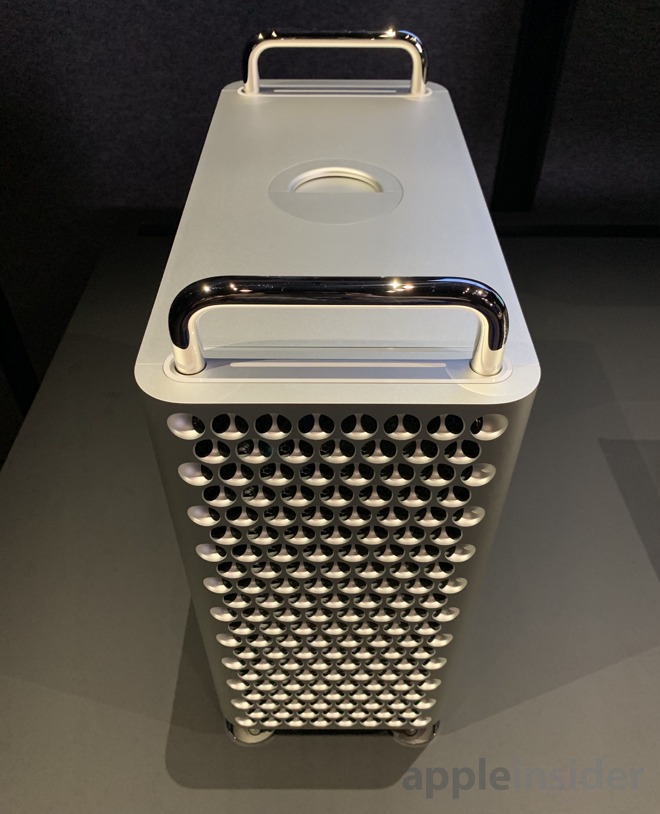
What a reversal from 1994: PC users are giggling at the appearance of the powerful Mac Pro while gushing over whimpy expensive tablets with a stylus
Apple is also leveraging the even more incredibly vast sales volumes of iPhones to bring iOS innovations to its computing platforms. That originally created the market for iPad-- a feat that Android phone makers haven't been able to duplicate. Even Samsung couldn't translate its high volumes of commodity phones into a real business for tablets comparable to iPad.
Apple is now leveraging the iPad to enhance the Mac. That includes its work on Catalyst, which taps the development power of iOS to create new native, desktop titles for Macs. Apple is also building development tools that span its hardware platforms, ranging from SwiftUI to Metal. Microsoft conversely announced a variety of hardware platforms that Windows 10 was supposed to span, but it turns out there's really just one: the conventional PC, which sells at an average price well below $400. Surface just offers expensive versions of the PC.
That makes it particularly ironic that the critics who despised Apple as being nothing more than an overpriced PC maker have now pivoted to a narrative that suggests Surface is a hotbed of innovation that is introducing new products and inventing new categories when it really isn't doing any of those things. It's just selling small numbers of expensive PCs.

Surface is all about the Microsoft logo
The slow quarter
Surface sales reported in Microsoft's third calendar quarter reached $1.06 billion, a 4 percent decrease over the year-ago quarter. But since 2014, Microsoft's Surface Q3 sales have always rolled in within 10% above or below $1 billion.That stagnancy reflects a conspicuous lack of progress for a unit hailed as by many fans as the creative center of the PC universe and perhaps the maker of best Windows PC one can buy.
Microsoft blamed the "timing of product lifecycle transitions" for lower Q3 sales this year. The company just showed off its refreshed Surface Pro 7, Surface Pro X, and Surface Laptop 3 models earlier this month, so this quarter is certainly the slowest in the annual cycle of Surface as buyers waited for those products to become available.
The cyclical nature of Surface sales -- peaking in the December quarter and then collapsing in half before the next batch is released -- also indicates that Microsoft has created a marketing-driven cycle similar to Apple's historically seasonal sales of iPods, iPhones, and iPads, and its educational sales of Macs. The difference is that Microsoft's cycle doesn't move up and down that much.

Surface hasn't grown the way Apple's new product introductions have
Surface vs Apple's Other
If Microsoft were reaching business users, or creating a real foundation of buyers, its sales shouldn't be falling back down to 2014 levels in between its Christmas bumps. Compare the cyclical shift in Surface sales to Apple's "other hardware," the segment it now calls "Wearables, Home and Accessories."Five years ago, Apple's "other" sales including iPods and Apple TV were written off as immaterial by critics. Surface was starting its second year of sales and was shipping $900 million of product, just under half of Apple's $1.9 billion of other hardware revenues.
Over the five years since, Apple launched a series of "other" products that pundits like to say "don't move the needle," including Apple Watch, AirPods and HomePod. Microsoft has been applauded over the same period for introducing various unconventional PC designs and detachable notebooks, including everything from the inexpensive $400 Surface Go to $3,300 notebooks, a $4,800 Studio desktop, and even a $22,000 whiteboard called Hub.
Yet five years later, Microsoft's Surface unit is still turning in the same roughly $1 billion in revenues. Apple's other hardware revenue has crept upward from twice that of Surface to three times, and while Apple hasn't yet reported figures for its calendar Q3, it most recently reported more than four times Surface revenue from its 'other hardware' sales: over $5.5 billion in the June quarter, compared to Surface with almost $1.4 billion.
Apple's significantly growing 'other hardware' represents innovative new product categories and initiatives in emerging areas such as wearables and home audio. Surface has repeatedly tried to polish the Bill Gates notion of a convertable Tablet PC to look more like an iPad, without much real-world success at all.
Microsoft's Surface peaks aren't very high
Over the last holiday season, Microsoft Surface sales reached an all-time quarterly high of $1.86 billion in revenues, almost twice its billion-dollar baseline. But actual hit hardware products should be reaching a higher peak on cyclical sales. Apple's iPod historically tripled its sales in the holiday quarter, then tripled upon that again the next year. Surface keeps falling back to the same baseline. That's not growth.Apple's "other hardware" also hit a cycle high over the last holiday quarter-- reaching revenues of $7.3 billion, nearly four times the highest height of Surface. Yet the language used to describe Apple's "other" products and accessories is dismissive, while Surface is hailed as "showing real growth" and "really seriously becoming a business now." Why does a company with an often higher market valuation than Apple need to be appeased with participation trophies and pats on the back for failing to appreciably grow and earn money?
Across its product lines, Apple has always driven annually cyclical sales. But sales of PCs are less cyclical. If Surface were reaching enterprise customers and selling to businesses, it should be seeing sales patterns more like HP, Dell, and Samsung, which are far less cyclical than Apple. That indicates that rather than building a real base of demand for its creative PC designs, Microsoft has instead only created a niche of fans that it serves with waves of replacements.
Reaching modern, mobile PC buyers
It's unflattering to compare the sales growth of Surface to Apple's "other hardware," but it's more realistic to compare Microsoft's sales of PCs, notebooks, and tablets to the same type of sales across Apple's non-iPhone products. It's also quite devastating.Surface originally appeared as a response to the iPad, which immediately began crushing PC sales after it appeared in 2010 and began Disrupting the market. Common PCs and notebooks were over-serving most users' needs while introducing excessive complication into their lives. The super-simple and highly mobile iPad appealed to everyone from children to business executives.
To blunt the iPad's impact and shore up Windows sales, Microsoft intended to deliver an "RT" version of its platform capable of running on the same kind of light, power-efficient ARM hardware Apple was delivering.

Surface RT was suposed to be the PC for iPad users
Microsoft's original Surface model was a $400 ARM-based Windows RT product, flanked by a more conventional, low-voltage x86 Surface Pro model that the company compared to Apple's MacBooks. Surface RT flopped dramatically across four years of trying because it didn't do what Windows customers expected of a Windows device: run most Windows software. That left Microsoft to focus on Surface Pro as its mobile, x86 PC tablet designed to be used with a keyboard and stylus.
The getup of Go got up and went
Last year, Microsoft ventured back into lower prices with Surface Go, also powered by a low-end x86 chip. Go was intended to drive higher volume sales with its lower price, and the $400 product certainly sold better than the much more expensive Pro, which is priced like a MacBook. But there wasn't any evidence that the Surface Go achieved significant sales volumes or made any money. The product category hasn't been refreshed since.Gartner did, however, claim last fall that Microsoft had importantly entered the top five PC makers in the U.S. The only way Gartner could make that claim is by comparing Surface against none of its actual competitors. It excluded sales of both Chromebooks and iPads, effectively measuring Microsoft against itself and the four much larger conventional PC makers in the U.S. that include Apple's Macs on their own.
Tom Warren of the Verge reported the facts that outlined what a sham "achievement" this was for Surface after six years of trying, but that same site also continues to declare that Microsoft is "a top five vendor," even though the reality is that Gartner only ever estimated quarterly sales of 600 thousand Surface units in the U.S. And unlike Apple, Microsoft's Surface is largely sold in the U.S. It only has two retail stores outside of North America.
Surface Expensive
Microsoft has also tried to move upscale with Surface Book, a product introduced in 2015 priced between $1,500 and $3,300 and compared to MacBook Pro models. In 2017 it added Surface Laptop, an $800 to $2,700 tablet compared to iPad Pro or MacBook Air. It also introduced Surface Studio, a desktop with a display that folds down into a drawing surface, starting at $3,000.Despite such a broad range of products -- growing from two to five broad product lines of PCs -- Surface sales haven't materially grown into a business, and certainly not one comparable to Apple's iPads or its Macs. Why is the monopoly platform of Windows unable to reach buyers with its hardware at any price?

An unhinged Surface PC reflects the tech media's enrapturement with impractical, unsuccessful experimentation
Apple's sales of iPads peaked in 2014 with sales of $8.9 billion, right before Apple began selling larger iPhones that erased some of the markets for standalone tablets. Yet for all the ink spilled on the collapse of iPad, Apple's tablet sales have remained a $4-5 billion quarterly business. Similarly, Mac sales have hit peaks of around $7.5 billion in some quarters, but are pretty solidly selling at around $6 billion per quarter. Combined, Apple's non-iPhone computing hardware sales are around $10 billion per quarter-- peaking above $14 billion over the last holiday season, where Surface hit its all-time high of $1.8 billion.
Surface has a larger problem than just being much smaller than Apple. It's not large enough to be sustainably profitable. Microsoft reports Surface revenues, but not profits. The company now maintains five product lines that compete with iPads and Macs, but only has a fraction of Apple's revenues. That's a lot of expensive design work, largely creating overlapping products that compete with each other over a finite market for premium-priced PCs. Microsoft also developed products it decided not to bring to market, including a mini tablet and a phone.
It is far more difficult for other billion-dollar companies to compete with Apple than it appears.
Under the Surface
While ostensively patterned after Apple, Microsoft's Surface business looks a lot more like Google's Pixel or Samsung's Galaxy: it's an expensive commodity, not just a premium tier. As such, it isn't resulting in a premium installed base of users, but rather merely selling an expensive version of regular products.While Apple's sales have been incrementally growing over time, it's more useful to note that Apple's ability to consistently turn in vast sales every quarter is adding up into a very large installed base of active users that keeps compounding, without resorting to cut-rate, high volume products to achieve that volume. Both of these factors are lost when comparing only unit sales and market share.
Apple's installed base of Macs is now well above 100 million, and its base of iPads is around 400 million. It would take Microsoft a hundred years to sell that many Surface products. So the skim of Surface sales occurring each year is just serving the thin layer of PC buyers who will pay extra for a Microsoft device, meaning many of them are repeat buyers, much the same as Pixel and Galaxy.
Apple does not have half a billion users constantly buying new Macs and iPads. Once users buy into the Apple ecosystem, they tend to stay there. But more importantly, they also buy other Apple products and services, including new categories the company introduces -- like Apple Watch, AirPods and HomePod -- as well as trying Services from iCloud to Arcade and TV+.
Microsoft's installed base of maybe ten million users isn't enough to drive similar hardware sales. That's a big part of why it failed to launch even its simple Microsoft Band and earbuds, and why there isn't a significant base to sell expensive products like the Studio. Similarly, it appears Apple's vast base of users will easily be able to support sustaining sales of Mac Pro even at prices from $6,000 to $20,000-- the price of Microsoft's wall-mounted Hub.

What a reversal from 1994: PC users are giggling at the appearance of the powerful Mac Pro while gushing over whimpy expensive tablets with a stylus
Apple is also leveraging the even more incredibly vast sales volumes of iPhones to bring iOS innovations to its computing platforms. That originally created the market for iPad-- a feat that Android phone makers haven't been able to duplicate. Even Samsung couldn't translate its high volumes of commodity phones into a real business for tablets comparable to iPad.
Apple is now leveraging the iPad to enhance the Mac. That includes its work on Catalyst, which taps the development power of iOS to create new native, desktop titles for Macs. Apple is also building development tools that span its hardware platforms, ranging from SwiftUI to Metal. Microsoft conversely announced a variety of hardware platforms that Windows 10 was supposed to span, but it turns out there's really just one: the conventional PC, which sells at an average price well below $400. Surface just offers expensive versions of the PC.
That makes it particularly ironic that the critics who despised Apple as being nothing more than an overpriced PC maker have now pivoted to a narrative that suggests Surface is a hotbed of innovation that is introducing new products and inventing new categories when it really isn't doing any of those things. It's just selling small numbers of expensive PCs.


Comments
If you want to use the Mac or iOS operating system you have a single source with a very limited selection. Every Apple OS user will be buying from that single source even if distributed via a few retail partners. Every sale of product will be recorded by Apple. Some people will simply accept the feature or form limitations offered thru that small selection of products (relatively speaking) in order to use their preferred OS. That results in big Apple product numbers.
Obviously the same restrictions don't apply to Microsoft's OS (or Android for that matter). thousands of variations and builds and form factors with only the OS they rely on being the common thread. Product sales will be recognized by who knows how many different OEM's. Don't like the Surface keyboard or memory options or form factor or price? There's options from not-Microsoft companies that might be more pleasing, no need to accept any limitations beyond those flowing from the OS itself. Pick and choose the specific unit from whatever company you think matches best with your wants/needs.
Otherwise the typical creatively written DED article. I love his way with words, excellent stuff.
If you aren't Apple, you are crap!
However, don't kid yourself, they were far from 'magical'.
They served a purpose just as the iPod Touch did but were extremely limited when it came to active use.
Later, when Pages et al arrived there were some serious file format issues between the different versions and email attachments would be a HUGE problem for years after.
In my experience the iPad Mini 2 was when the stars aligned for iPad (although email attachments were still a curse!).
For me, I want my Tablet to just work!!! Unlike Windows where I now have to deal with Anti-Virus software, Firewalls, Spyware software, etc, etc. My iPad just turns on and I can start using it.
Microsoft Surface Quarterly revenue gains / losses since the last revenue decrease in 2017 Q4:
2020 Q1 -4%
2019 Q4 +14%
2019 Q3 +21%
2019 Q2 +39%
2019 Q1 +14%
2018 Q4 +25%
2018 Q3 +32%
2018 Q2 +1%
2018 Q1 +12%
2017 Q4 -2%
Source:
https://www.microsoft.com/en-us/Investor/earnings
If the next 2+ quarters are bad then sure a trend is forming... this current decrease is likely a mere blip. The new product lines should ensure decent growth through the next 2 years.
It still doesn't check all the boxes yet. There are some very basic things missing that I can only do on my Mac, but there are times where I can spend half my day sitting out on my deck and getting actual work done. This wasn't possible on the first few generations.
Other than the touchpad and Windows being Windows it's a great device. The touchscreen and pen input is perfect for taking notes in lectures and Windows being Windows allows me to use the programs required for class without issues.
There are some nice aspects to it, like the USB-A port in the mobile power brick, the hub built into the power brick at the house, and a decent display compared to most Windows PCs I encounter, but mostly it's not a great experience.
I assume that they couldn't do what they need if they switched to the iPad because of their CRM SW. I come to this conclusion because the iPad TCO would be considerably less expensive if their home-grown CRM SW worked via iPadOS.